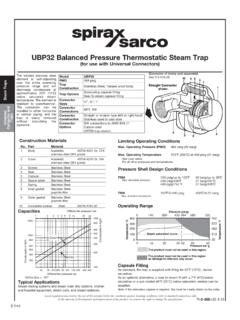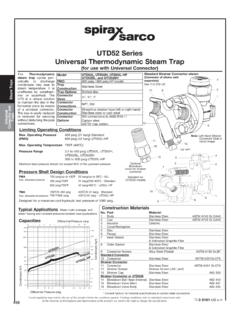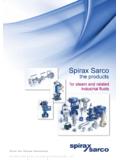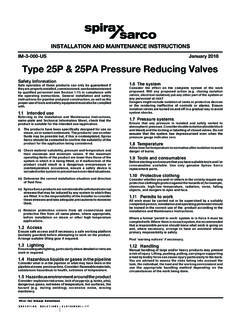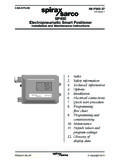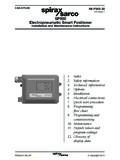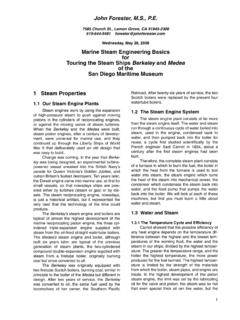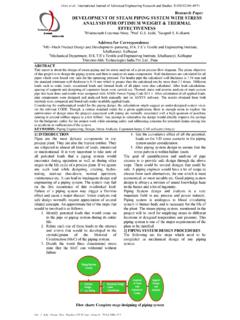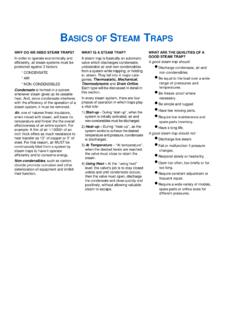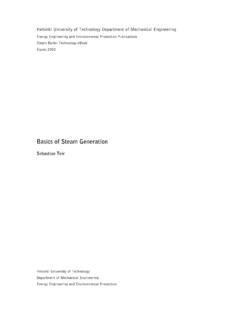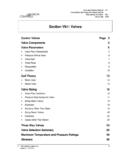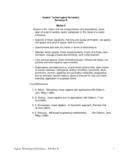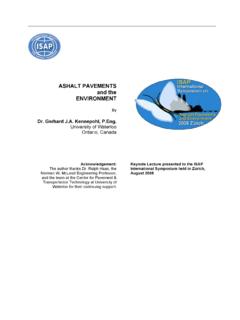Transcription of Published by - Spirax Sarco
1 2 Published by$ per copyCopyright 2017by Spirax Sarco , Rights ReservedNo part of this publication may be reproduced, stored in aretrieval system or transmitted, in any form or by any means,electronic, mechanical, photocopying, recording, or otherwise,without the prior written permission of the the on-going need for education as it relates to the fundamentals of steam including the most efficient use of its heat content, Spirax Sarco has developed the steam Utilization Course. This handbook represents over 100 years of steam experience in the proper selection, sizing and application of steam traps, pressure and temperature controls, and condensate recovery systems in major industrial plants throughout the world. The steam Utilization Course can be used in conjunction with Design of Fluid Systems Hook Ups for a complete and concise knowledge of the use of steam for Sarco , Northpoint , SC SarcoSpirax Sarco is the recognized industry standard for knowledge and products and for over 100 years has been committed to servicing the steam users worldwide.
2 The existing and potential applications for steam , water and air are virtually unlimited. Beginning with steam generation, through distribution and uti-lization and ultimately returning condensate to the boiler, Spirax Sarco has the solutions to optimize steam system performance and increase productivity to save valuable time and today s economy, corporations are looking for reli-able products and services to expedite processes and alleviate workers of problems which may arise with their steam systems. As support to industries around the globe, Spirax Sarco offers decades of experience, knowledge, and expert advice to steam users world-wide on the proper control and conditioning of steam systems. Spirax Sarco draws upon its worldwide resources of over 4000 people to bring complete and thorough service to steam users.
3 This service is built into our products as a performance guarantee. From initial consultation to effective solutions, our goal is to manufacture safe, reliable products that improve productivity. With a quick, responsive team of sales engineers and a dedicated network of local authorized distributors Spirax Sarco provides quality service and support with fast, efficient steam system components are at the heart of Spirax Sarco s commitment. Controls and regula-tors for ideal temperature, pressure and flow control; steam traps for efficient drainage of condensate for maximum heat transfer; flowmeters for precise mea-surement of liquids; liquid drain traps for automatic and continuous drain trap operation to boost system efficiency; rotary filters for increased productivity through proper filtering of fluids; condensate recovery pumps for effective condensate management to save water and sewage costs; stainless steel specialty products for maintaining quality and purity of steam ; and a full range of pipeline auxiliaries, all work together to produce a productive steam system.
4 Spirax Sarco s new line of engineered equipment reduces installation costs with prefabricated assemblies and fabricated modules for system integrity and turnkey advantages. From large oil refineries and chemical plants to local laundries, from horticulture to shipping, for hospitals, universities, offices and hotels, in business and gov-ernment, wherever steam , hot water and compressed air is generated and handled effectively and efficiently, Spirax Sarco is there with knowledge and experience. For assistance with the installation or operation of any Spirax Sarco product or application, call toll free:1-800-883-44114 Contents 4 BASIC steam engineering PRINCIPLES 6 INTRODUCTION 6 WHAT IS steam 6 DEFINITIONS 6 THE FORMATION OF steam 6 steam Saturation Table 8 steam GENERATION 10 BOILERS & BOILER EFFICIENCY 10 SELECTION OF WORKING PRESSURES 11 steam Velocity 12 Air and Non-Condensable Gases 13 steam SYSTEM BASICS 14 steam PIPING DESIGN CONSIDERATIONS 15 steam AND CONDENSATE METERING 17 WHY MEASURE steam ?
5 18 Plant Efficiency 18 Energy Efficiency 18 Process Control 18 Costing and Custody Transfer 18 CONTROL AND REGULATION OF steam 19 PRESSURE REDUCING VALVES 19 Direct Acting Valves 19 Pilot Operated Valves 20 Selection and Application 21 TEMPERATURE CONTROL VALVES 22 Manual Controls 22 Self-Acting Controls 22 Pilot Operated Controls 23 Pneumatic Controls 24 Proportional Control Bands 24 steam TRAPS AND THE REMOVAL OF CONDENSATE 26 CONDENSATE REMOVAL 26 Air Venting 27 Thermal Efficiency 27 Reliability 275 steam TRAPS 27 Mechanical steam Traps 28 Thermostatically or Temperature Controlled Traps 30 Thermodynamic steam Traps 32 Variations on steam Traps 33 Swivel Connector Traps 37 steam TRAP TESTING METHODS 37 Visual Testing 37 Ultrasonic Trap Testing 37 Temperature Testing 38 Conductivity Testing 38 Wireless steam Trap Monitoring 39 BY-PASSES AROUND steam TRAPS 40 PREVENTIVE MAINTENANCE PROGRAMS 40 steam Trap Fault Finding 40 steam Trap Discharge Characteristics 42 steam TRAP SELECTION 42
6 Waterlogging 42 Lifting of Condensate 43 REQUIREMENTS FOR steam TRAP/APPLICATIONS 43 Application Requirements 43 steam Trap Selection Chart 44 steam Trap Sizing 45 steam TRACING 46 CRITICAL TRACING 46 NON-CRITICAL TRACING 46 Attaching Tracer Lines 47 JACKETED PIPE TRACERS 48 steam TRACING MANIFOLDS 49 CONDENSATE MANIFOLDS 49 CONDENSATE MANAGEMENT 51 FLASH steam RECOVERY 52 CONDENSATE RECOVERY SYSTEMS 56 Electrically Driven Pumps 58 Non Electric Pressure Powered Pumps 59 WATERHAMMER IN CONDENSATE RETURN LINES 61 steam UTILIZATION COURSE REVIEW 63 Contents56 Basic steam engineering Principals6 Introduction This Spirax Sarco steam Utilization Course is intended to cover the basic fundamentals and
7 Efficient usage of steam as a cost effective conveyor of energy (Fig. 2) to space heating or pro-cess heating equipment. The use of steam for power generation is a specialized subject, already well documented, and is outside the scope of this course. This course has been designed and written for those engaged in the design, opera-tion, maintenance and or general care of a steam system. A mod-erate knowledge of physics is assumed. The first part of this course attempts to define the basic terminology and principles involved in steam generation and system Is steam Like many other sub-stances, water can exist in the form of either a solid, liquid, or gas. We will focus largely on liquid and gas phases and the changes that occur during the transition between these two phases.
8 steam is the vaporized state of water which contains heat energy intended for transfer into a variety of processes from air heating to vaporizing liquids in the refining process. Perhaps the first thing that we should do is define some of the basic terminology that will be used in this The basic unit of measure-ment for all types of heat energy is the British Thermal Unit or BTU. Specifically, it is the amount of heat energy necessary to raise one pound of water one degree A degree of hot or cold mea-sured on a definite scale. For all practical purposes a measure-ment from a known starting point to a known ending EnergySaturation The point where a substance can hold no more energy without changing phase (physical state).Enthalpy The term given for the total energy, measured in BTU s, due to both pressure and temperature of a fluid or vapor, at any given time or Pressure (PSIG) Pressure shown on a stan-dard gauge and indicated the pressure above atmospheric Pressure (PSIA) The pressure from and above perfect vacuumSensible Heat (hf) The heat energy that raises the water temperature from 32 F.
9 The maximum amount of sensible heat the water can absorb is determined by the pressure of the liquid. (Fig 1 & 2)Latent Heat (hfg) The enthalpy of evaporation. The heat input which produces a change of water from liquid to Heat Is the sum of sensible heat and latent heat (ht=hf+hhfg). (Fig 1)The Formation of steam steam is created from the boiling of water. As heat energy (BTU s) is added to water, the temperature rises accordingly. When water reaches its saturation point, it begins to change from a liquid to a gas. Let s investigate how this happens by placing a thermometer in one pound of water at a temperature of 32 F, which is the coldest temperature water can exist at atmospheric pressure before changing from liquid to a solid.
10 Let s put this water into a pan on top of our stove and turn on the burner. Heat energy from the burner will be transferred through the pan into the water, causing the water s temperature to rise. We can actually monitor the heat energy transfer ( ) by watching the thermometer level rise - one BTU of heat energy will raise one pound of water by one degree Fahrenheit. As each degree of temperature rise is registered on the thermometer, we can read that as the addition of 1 BTU. Eventually, the water temperature will rise to its boil-ing point (saturation temperature) at atmospheric pressure, which is 212 F at sea level. Any addi-tional heat energy that we add at this point will cause the water to begin changing state (phase) from a liquid to a gas ( steam ).
